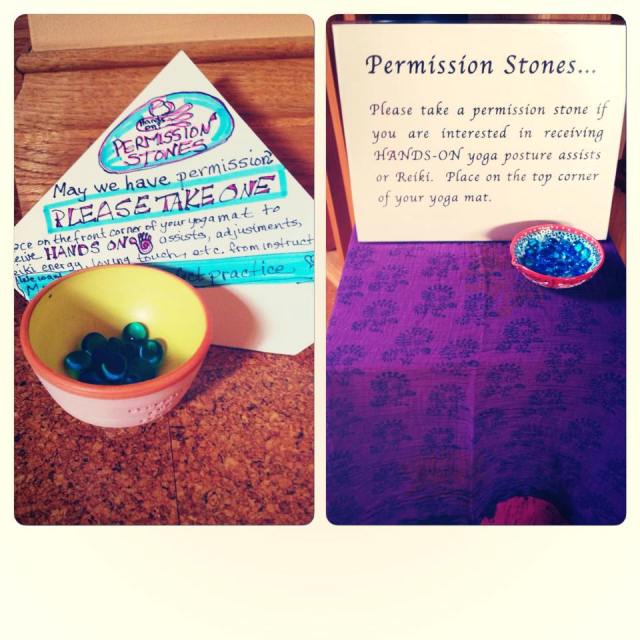
It’s a new day, new month, new year, and new decade. Let’s ask. Let’s ask for permission before touching a practitioner in a yoga (asana) class.
In 2015 one of our teachers sent me an article (thanks Jenna) about fellow yoga teachers using permission stones in their yoga classes. These permission stones give practitioners the option to choose and give consent for physical touch. When I first read the article, I thought it was brilliant. I also thought, “HELLO!!!! How have we not been doing this all along.” We immediately implemented using permission stones at World Peace Yoga and it was well received by both teachers and practitioners.
Why weren’t we doing this all along? It simply has not been part of the yoga culture to ask before assisting someone in a class. You just did it….and this has been passed on in teacher training after teacher training, until more recently. When I first started teaching, it did not cross my mind to ask practitioners for permission to give hands on assists. For the most part I felt comfortable assisting people and I often let the practitioners know that I offer assists in class (without considering whether or not they might like being assisted with touch). There were times I felt hesitant to give an assist and did not and there were times I got close to someone (not yet touching them) and they quickly warned me of a recent surgery or injury. And, I imagine there may have been times where an assist I gave turned someone off from coming back to class.
When I started using the permission stones in class, it eliminated the guesswork and created a safer space for the practitioners, putting them in control to choose. Being in this space of choice felt safer to me as both a practitioner and teacher. That being said, permission and consent is not the end all be all. It is a start to building trust. Even with consent, it is essential to consider the assist itself and the purpose, which is to benefit and enhance the practitioner’s experience. An assist is not a performance. It does not validate touching intimate areas of the body. It is not to force someone’s body into a particular shape. It is not even a “correction.” It is for the enhancement of the practitioner’s experience.
I believe touch and assists have the potential to be incredibly healing, to break down barriers, and to build community. For some, touch and assists are debilitating and it’s important to recognize that. One may choose to not be touched for a variety of reasons from sore muscle recovery to trauma associated with touch. Whatever the reason may be, it’s important to respect it.
Let’s make 2020 the year and decade of respect, asking permission, consent and creating safer spaces.
Ways to ask permission:
Permission Stones: Practitioners take a stone and place on their mat if they are interested in touch/assists.
Consent Cards: All practitioners receive a card that is red on one side and green on the other. This gives practitioners the option to choose what parts of class they may or may not like touch/assists.
In Class: At the start of class, offer students to close eyes and place hand on belly if they prefer no touch/assists. This may also be done again when practitioners lie down for relaxation.
Anna Ferguson is the co-creator of World Peace Yoga, a style of yoga that inspires peace in action, developing intuition, deepening empathy, and expanding compassion. She is also the author of World Peace Yoga: Yoga for People Who Breathe. You may connect with Anna via Facebook or Instagram. Make sure to check out the Cincy State of Being article on How One Yoga Studio is Bringing US Closer to Achieving World Peace.
Related Articles:
Yoga Is Finally Facing Consent and Unwanted Touch
In Yoga, Burry Lines easily Crossed
Pedagogy of Abuse
